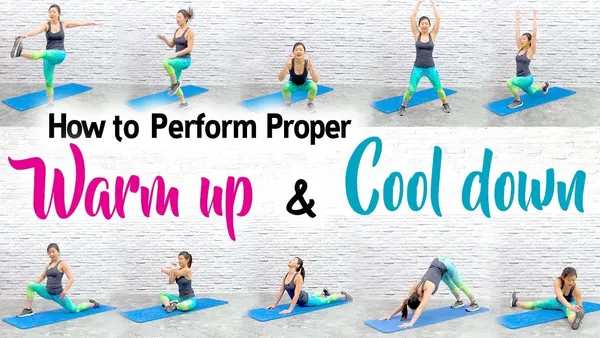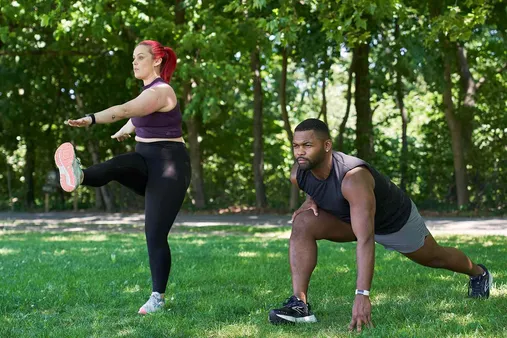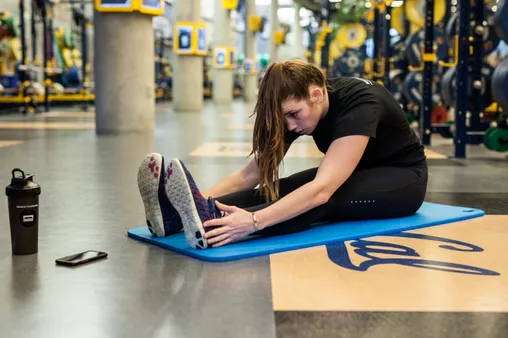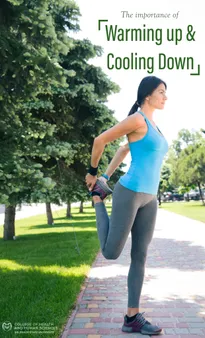Table of Contents
Welcome to Kizworld, your ultimate guide to fitness and well-being. In this comprehensive guide, we'll delve into the art of warming up and cooling down, essential practices often overlooked in workout routines. Discover how these simple yet effective techniques can transform your exercise experience, reducing the risk of injuries, maximizing performance, and promoting faster recovery. Learn "How to do a warm-up and cool-down" properly, setting the stage for a safe and productive workout journey.
How to do a warm-up and cool-down: The Ultimate Guide for Fitness Enthusiasts
I. Warm-Up Exercises
Warm-Up Exercises
Dynamic Stretches
Dynamic stretches are a great way to warm up your muscles and prepare them for exercise. They involve moving your muscles through their full range of motion while keeping them relaxed. Some examples of dynamic stretches include arm circles, leg swings, and torso twists. These stretches help to increase your heart rate and blood flow, which can improve your performance and reduce your risk of injury.
- Arm circles: Rotate your arms in a circular motion, starting small and gradually increasing the size of the circles.
- Leg swings: Swing your legs forward and backward, keeping your knees slightly bent.
- Torso twists: Stand with your feet shoulder-width apart and your knees slightly bent. Twist your torso to the right, then to the left, keeping your hips and shoulders square to the front.
Cardiovascular Exercises
Cardiovascular exercises are also a great way to warm up your body before exercise. These exercises get your heart rate up and increase blood flow to your muscles. Some examples of cardiovascular exercises include running, cycling, and swimming. Aim for at least 5-10 minutes of cardiovascular exercise before your workout.
- Running: Jog or run at a moderate pace for 5-10 minutes.
- Cycling: Ride a stationary bike or go for a bike ride outside for 5-10 minutes.
- Swimming: Swim laps or do water aerobics for 5-10 minutes.
Activation Exercises
Activation exercises are designed to target specific muscle groups that are important for your chosen activity. These exercises help to "turn on" these muscles and prepare them for work. Some examples of activation exercises include squats, lunges, and push-ups. Aim for 2-3 sets of 10-12 repetitions of each activation exercise.
- Squats: Stand with your feet shoulder-width apart and your toes turned out slightly. Bend your knees and lower your body until your thighs are parallel to the ground. Press through your heels to return to the starting position.
- Lunges: Step forward with one leg and bend your knee so that your thigh is parallel to the ground. Keep your other leg straight and your heel on the ground. Press through your front heel to return to the starting position.
- Push-ups: Start in a plank position with your hands shoulder-width apart and your feet together. Bend your elbows and lower your body until your chest is almost touching the ground. Press through your hands to return to the starting position.
II. Benefits of Warming Up
Benefits of Warming Up
Improved Performance
- Increased muscle temperature and blood flow
- Enhanced oxygen and nutrient delivery to muscles
- Faster muscle contraction and relaxation
- Improved muscle coordination and efficiency
As you move, your muscles contract and relax, generating heat, increased muscle temperature can facilitate faster muscle contractions and increase the speed and power of your movements. The best way to prepare your body for a workout is to warm up properly.
Reduced Risk of Injury
- Increased muscle flexibility and range of motion
- Less muscle tension and stiffness
- Reduced chance of muscle strains, sprains, and tears
Warming up can significantly reduce your risk of injury and enhance your performance. It's an essential part of any workout, and taking just a few minutes to warm up can make a big difference.
Enhanced Mental Focus
- Improved concentration and alertness
- Reduced anxiety and stress
- Increased motivation and confidence
In conclusion, warming up has numerous benefits that can enhance your workout experience and help you achieve your fitness goals. So, make sure to incorporate a dynamic warm-up into your routine before every workout session. Discover more ways to improve your flexibility and mobility in our blog post.
III. Cool-Down Exercises
Cool-Down Exercises
- Static Stretches: Hold each stretch for 30 seconds to 60 seconds, focusing on major muscle groups like quads, hamstrings, glutes, chest, shoulders, and back.
- Foam Rolling: Use a foam roller to apply pressure to tense muscles, aiding in recovery and reducing muscle soreness.
- Light Cardiovascular Exercise: Engage in 5-10 minutes of low-intensity activity like jogging or brisk walking to promote blood flow and assist in muscle recovery.
By incorporating these cool-down exercises into your routine, you can enhance your recovery process, minimize muscle soreness, and improve your overall flexibility.
Related Posts:
- How to Do a Handstand: A Step-by-Step Guide with Tips & Benefits
- The Best Gymnastics Equipment for Home Use: A Comprehensive Guide
- The Best Gymnastics Books and Podcasts: A Resource Guide for Athletes and Coaches
- The Best Gymnastics Music and Playlists: Get Your Groove On While You Train
IV. Benefits of Cooling Down
Benefits of Cooling Down
Cooling down after exercise is just as important as warming up. It helps your body to recover from the exertion of exercise and can reduce muscle soreness, improve flexibility, and aid in recovery. Here are some of the benefits of cooling down:
- Reduced muscle soreness: Cooling down helps to remove lactic acid from your muscles, which can cause soreness.
- Improved flexibility: Cooling down helps to stretch your muscles, which can improve your flexibility.
- Aided recovery: Cooling down helps your body to recover from the exertion of exercise by restoring your heart rate and breathing to normal levels.
To cool down properly, you should do some light cardiovascular exercise for 5-10 minutes, such as walking or jogging. You should also do some static stretches for each of your major muscle groups. Hold each stretch for 30 seconds to 60 seconds. See our article on how to do a static stretch for more information.
Cooling down is an important part of any workout routine. By taking the time to cool down properly, you can help your body to recover from exercise and reduce your risk of injury.
V. Tips for Warming Up and Cooling Down
Here are some tips for warming up and cooling down effectively:
- Warm up before every workout: Even if you're just going for a light walk, it's important to warm up your muscles before you start exercising.
- Cool down after every workout: Don't just stop exercising and go about your day. Take the time to cool down properly to help your body recover.
- Listen to your body: If you're feeling pain or discomfort during your warm-up or cool-down, stop and rest. Don't push yourself too hard.
- Stay hydrated: Drink plenty of water before, during, and after your workout to stay hydrated.
- Wear appropriate clothing: Wear loose, comfortable clothing that will allow you to move freely.
By following these tips, you can help to ensure that you're warming up and cooling down effectively, which can help you to improve your performance and reduce your risk of injury.
VI. Conclusion
In conclusion, warming up and cooling down are integral parts of a well-rounded workout routine. By incorporating dynamic stretches, cardiovascular exercises, and activation exercises into your warm-up, you prime your body for optimal performance and minimize the risk of injuries. Conversely, cooling down with static stretches, foam rolling, and light cardiovascular exercise promotes muscle recovery, reduces soreness, and enhances flexibility. Remember to tailor your warm-up and cool-down routine to your fitness level and the specific activity you're engaging in. By making these practices a habit, you'll not only elevate your workout experience but also contribute to your overall health and well-being.